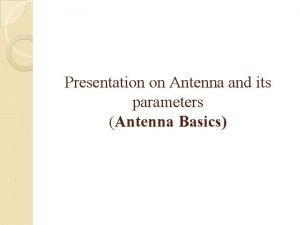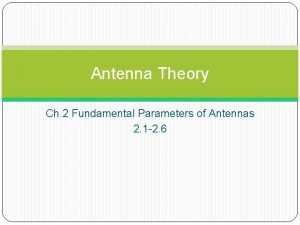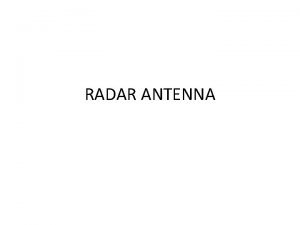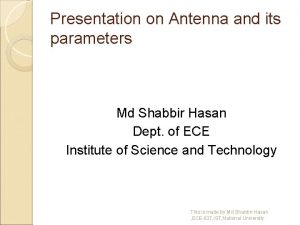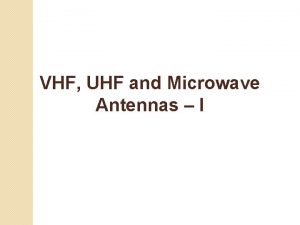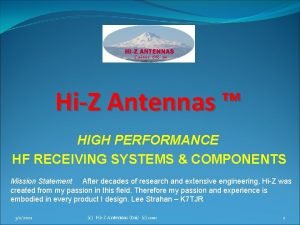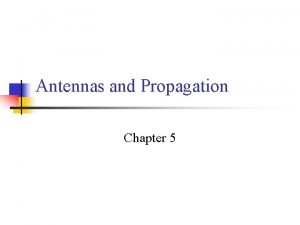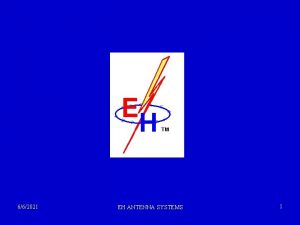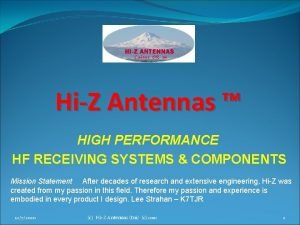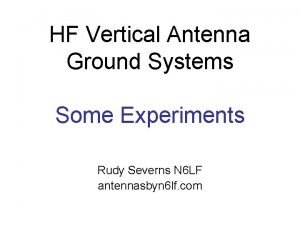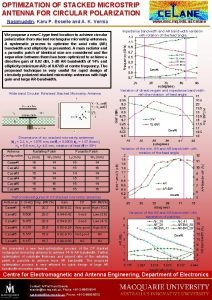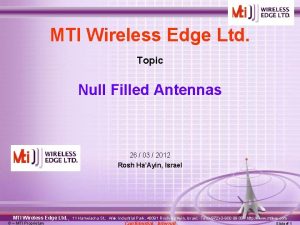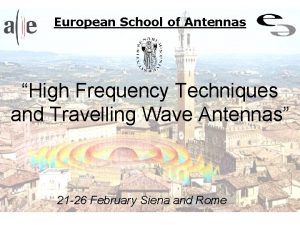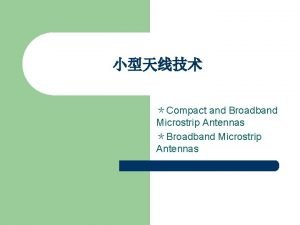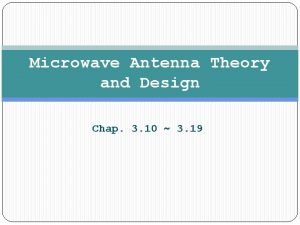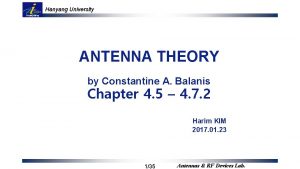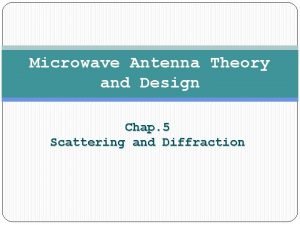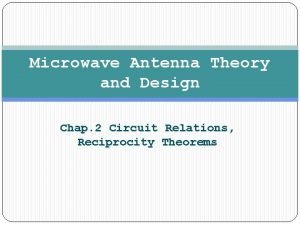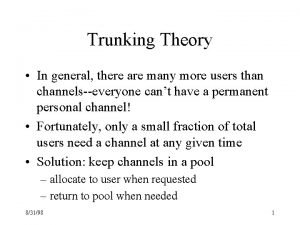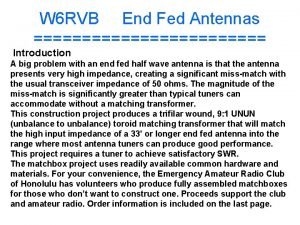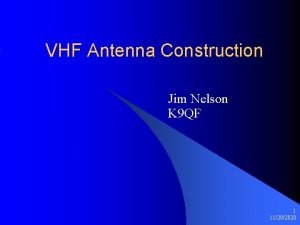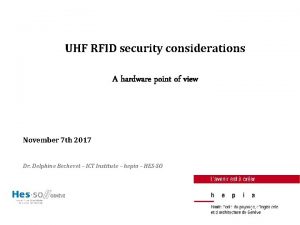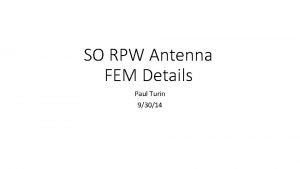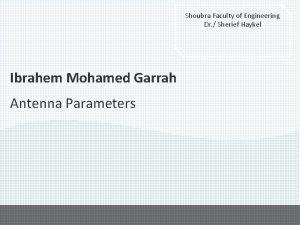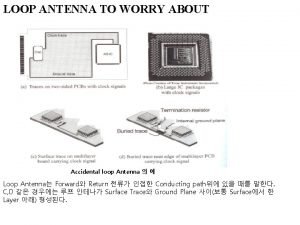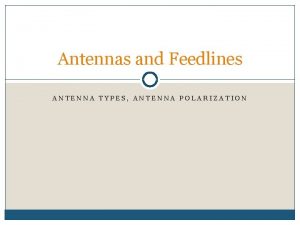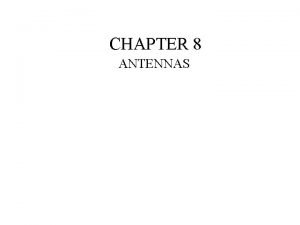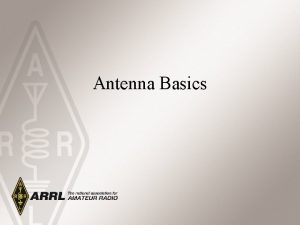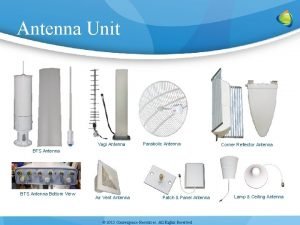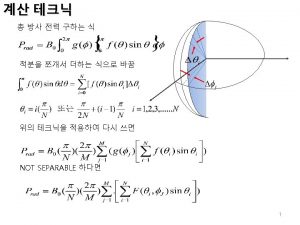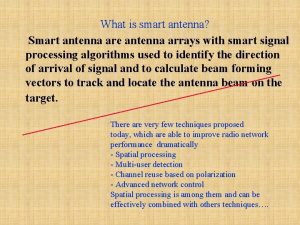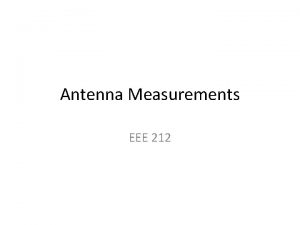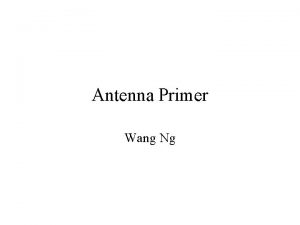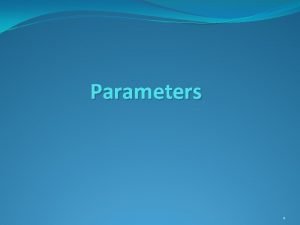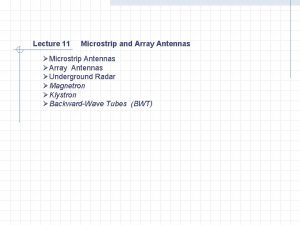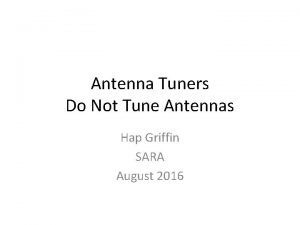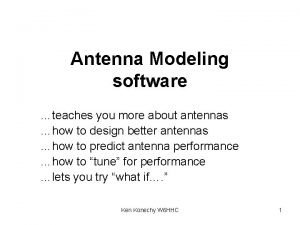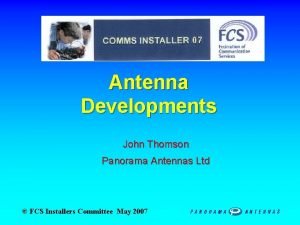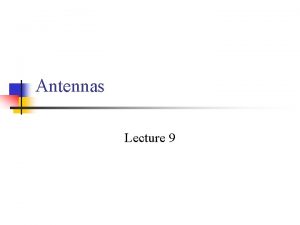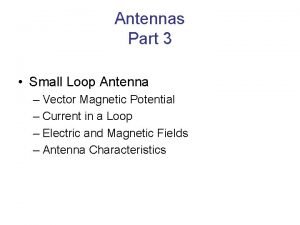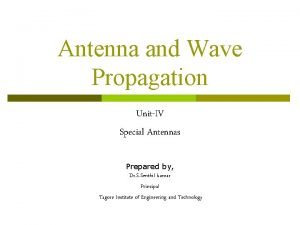Antenna Theory Ch 2 Fundamental Parameters of Antennas







![� Omnidirectional antenna: azimuth plane[f(Φ), θ=π/2]에 대해 nondirectional pattern을 갖고, orthogonal plane(elevation plane[g(θ), Φ=constant])에 � Omnidirectional antenna: azimuth plane[f(Φ), θ=π/2]에 대해 nondirectional pattern을 갖고, orthogonal plane(elevation plane[g(θ), Φ=constant])에](https://slidetodoc.com/presentation_image_h/dd05b6e8526ca852c203e45812f7e884/image-8.jpg)





















- Slides: 29

Antenna Theory Ch. 2 Fundamental Parameters of Antennas 2. 1 -2. 6




2. 2. 1 Radiation Pattern Lobes � Radiation pattern은 lobe라 불리우는 부분으로 나눌 수 있다 – major or main, minor, side, back. � Radiation lobe: radiation pattern 중 방사세기가 상대적으로 약한 부분에 둘러싸여 있 는 부분. 4


![Omnidirectional antenna azimuth planefΦ θπ2에 대해 nondirectional pattern을 갖고 orthogonal planeelevation planegθ Φconstant에 � Omnidirectional antenna: azimuth plane[f(Φ), θ=π/2]에 대해 nondirectional pattern을 갖고, orthogonal plane(elevation plane[g(θ), Φ=constant])에](https://slidetodoc.com/presentation_image_h/dd05b6e8526ca852c203e45812f7e884/image-8.jpg)
� Omnidirectional antenna: azimuth plane[f(Φ), θ=π/2]에 대해 nondirectional pattern을 갖고, orthogonal plane(elevation plane[g(θ), Φ=constant])에 대해 directional pattern 을 갖는 안테나. Directional antenna의 특별 케이스. 그림 2. 6 7

2. 2. 3 Principal Patterns � 선형 편파 안테나(linearly polarized antenna)의 성능은 안테나의 E-plane, H-plane에 의해 설명하기도 한다. � E-plane: 전계 벡터와 최대 방사의 방향을 포함하는 면 � H-plane: 자계 벡터와 최대 방사의 방향을 포함하는 면 � 그림 2. 5에서 x-z plane(elevation plane, Φ=0)이 E-plane이고, x-y plane(azimuth plane, θ=π/2)이 H-plane이다. � 그림 2. 6의 omnidirectional antenna는 무수히 많은 E-plane(elevation plane, Φ=Φc)를 가지며, 하나의 H-plane(azimuth plane, θ=π/2)을 가진다. 8

2. 2. 4 Field Regions � 안테나 주변의 공간은 다음의 세 구역으로 나눌 수 있다. � Reactive near-field region � Radiating near-field (Fresnel) region Reactive near-field region은 reactive field가 우세한 영역으로 안테나에 바로 근접해 있다. � Far-field (Fraunhofer) region Radiating near-field region은 radiation field가 우세한 영역으로 안테나와의 거 리에 따라 angular field distribution이 달 라지게 된다. 파장보다 안테나의 크기가 다르면 이 영역은 존재하지 않는다. Far-field region에서는 안테나와의 거리 에 대해 angular field distribution가 무관 하게 된다. 단, D는 안테나의 크기 9

� 영역에 따른 amplitude 의 변화 � Reactive near-field region – field가 거의 일정하게 퍼져있다. � Radiating near-field (Fresnel) region – lobe를 형성한다. � Far-field (Fraunhofer) region – major lobe와 몇몇의 minor lobe가 형성된다. 10



2. 3 Radiation Power Density � 전자파는 무선 매질이나 도파구조를 통해 정보를 전달하는데 사용된다. � 전자파와 관련된 전력을 나타낼 때 사용되는 양은 instantaneous Poynting vector로 아래와 같이 정의된다. � W = instantaneous Poynting vector (W/m 2) � E = instantaneous electric-field intensity (V/m) � H = instantaneous magnetic-field intensity (A/m) � 포인팅 벡터는 전력밀도이기 때문에 폐곡면을 지나는 total power는 포인팅 벡터의 수직 성분을 전체 표면에 대해 적분하여 구할 수 있다. � P = instantaneous total power (W) � = unit vector normal to the surface � da = infinitesimal area of the closed surface (m 2) 13



2. 4 Radiation Intensity � 주어진 방향에서의 방사 세기는 안테나의 단위 입체각으로부터 방사되는 전력으로 정의된다. 이는 far-field 파라미터이며, radiation density와 거리의 제곱의 곱으로 나 타낼 수 있다. � U = radiation intensity (W/unit solid angle) � Wrad = radiation density (W/m 2) � Radiation intensity는 안테나의 far-field region 전계와 아래와 같은 관계를 갖는다. � E(r, θ, Φ) = far-zone electric-field intensity of the antenna = � Eθ, EΦ = far-zone electric-field components of the antenna � η = intrinsic impedance of the medium 16

� 전체 전력은 radiation intensity를 전체 입체각 4π에 걸쳐 적분하여 구할 수 있다. � Isotropic source U에 대한 radiation intensity는 radiation power density와 마찬가지로 θ, Φ에 대해 무관하다. � Isotropic source에 대한 radiation intensity는 17


� 안테나의 beamwidth는 중요한 지표로서 side lobe level과 beamwidth는 trade-off로 사용되기도 한다 – beamwidth가 감소하면 side lobe level이 증가 하고 beamwidth가 증가하면 side lobe level이 감소하게 된다. 19

2. 6 Directivity � Directivity란 모든 방향에 걸친 average radiation intensity에 대한 주어진 방향으로의 radiation intensity의 비로 아래의 식과 같이 나타낸다. � 방향이 주어져 있지 않다면 이는 최대 방사세기의 방향을 의미하며 다음과 같은 식으 로 나타낼 수 있다. � D = Directivity (dimensionless) � D 0 = maximum directivity (dimensionless) � U = radiation intensity (W/unit solid angle) � Umax = maximum radiation intensity (W/unit solid angle) � U 0 = radiation intensity of isotropic source (W/unit solid angle) � Prad = total radiated power (W) � Isotropic source에 대해 U, Umax, U 0가 모두 동일하므로 directivity은 1이 된다. 20

� 직교 편파 성분을 갖는 안테나에 대해 주어진 방향에서 주어진 편파에 대한 안테나의 부분적인 지향성(partial directivity of an antenna for a given polarization in a given direction)은 주어진 편파에 대한 radiation intensity를 전체 방향에 걸쳐 평균한 total radiation intensity로 나눈 값으로 정의한다. � Partial directivity에 대한 정의로부터, 주어진 방향에서의 total directivity는 두 직교편 파에 대한 partial directivity의 합이다. 구좌표계에서 안테나의 직교하는 θ, Φ성분에 대한 total directivity는 다음과 같이 쓸 수 있다. � Uθ = radiation intensity in a given direction contained in θ field component � UΦ = radiation intensity in a given direction contained in Φ field component � (Prad)θ = radiated power in all directions contained in θ field component � (Prad)Φ = radiated power in all directions contained in Φ field component 21







� Omnidirectional pattern에 대한 근사 directivity 공식은 � Minor lobe가 있는 경우 � Minor lobe가 없는 경우 28
 Antenna parameters
Antenna parameters Fundamental parameters of antenna
Fundamental parameters of antenna Radar antenna gain
Radar antenna gain Antenna parameters
Antenna parameters Vhf uhf and microwave antennas
Vhf uhf and microwave antennas Hi z antennas
Hi z antennas Stacking yagi antennas
Stacking yagi antennas Antennas and propagation
Antennas and propagation Eh antenna theory
Eh antenna theory K7tjr
K7tjr Hi-q antennas
Hi-q antennas N6lf radials
N6lf radials Nasimuddin+microstrip+antennas
Nasimuddin+microstrip+antennas (“mti wireless edge” or mtiwe) and anten
(“mti wireless edge” or mtiwe) and anten European school of antennas
European school of antennas Pj antennas
Pj antennas Broadband microstrip antennas
Broadband microstrip antennas R=zcosθ
R=zcosθ Finite length dipole antenna
Finite length dipole antenna Microwave antenna theory and design
Microwave antenna theory and design Microwave antenna theory and design
Microwave antenna theory and design Erlang b
Erlang b Maximum lift coefficient formula
Maximum lift coefficient formula End fed antenna length chart
End fed antenna length chart Nelson antenna
Nelson antenna Rfid antenna
Rfid antenna Stacer antenna
Stacer antenna Radiation intensity of antenna
Radiation intensity of antenna Sunsight microwave path alignment kit
Sunsight microwave path alignment kit Ground loop antenna
Ground loop antenna
